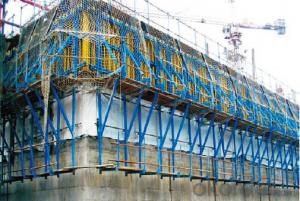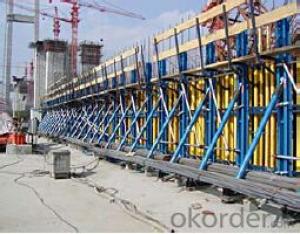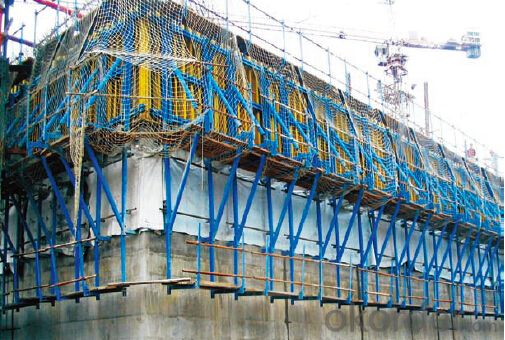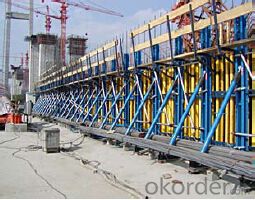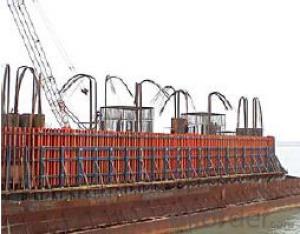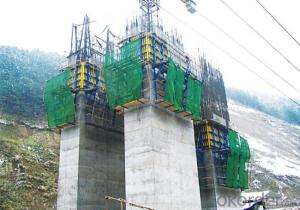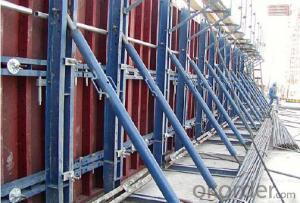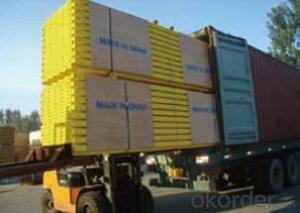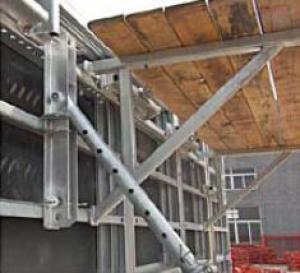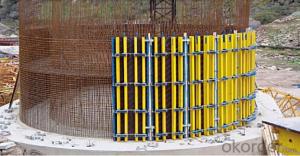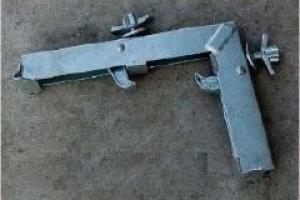Single-Side Climbing Bracket for formwork and scaffolding system
- Loading Port:
- Tianjin
- Payment Terms:
- TT OR LC
- Min Order Qty:
- 50 m²
- Supply Capability:
- 1000 m²/month
OKorder Service Pledge
OKorder Financial Service
You Might Also Like
Single-side Climbing Bracket SCB180:
With CNBM SCB 180 climbing systems, the loads from the fresh concrete pressure are
transferred through the brackets by means of V-strongbacks and compression braces into the
scaffold anchors.
Typical applications for the SCB 180 are dams, locks, cooling towers, pier heads, tunnels, and
bank vaults.
The formwork is simply tilted backwards when striking takes place. The 1.80 m wide bracket
requires only a minimum of space.
Characteristics:
◆ Economical and safe anchoring
The M30/D20 climbing cones have been designed especially for single-sided concreting using
SCB180 in dam construction, and to allow the transfer of high tensile and shear forces into the still
fresh, unreinforced concrete. Without wall-through tie-rods, finished concrete is perfect.
◆ Stable and cost-effective for high loads
generous bracket spacings allow large-area formwork units with optimal utilization of the bearing
capacity. This leads to extremely economical solutions.
◆ Simple and flexible planning
With SCB180 single-sided climbing formwork, circular structures can also be concreted without
undergoing any large planning process. Even use on inclined walls is feasible without any special
measures because additional concrete loads or lifting forces can be safely transferred into the
structure.
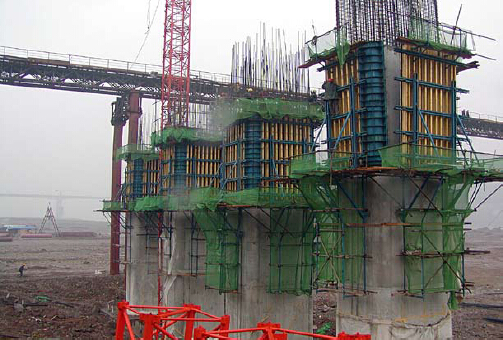
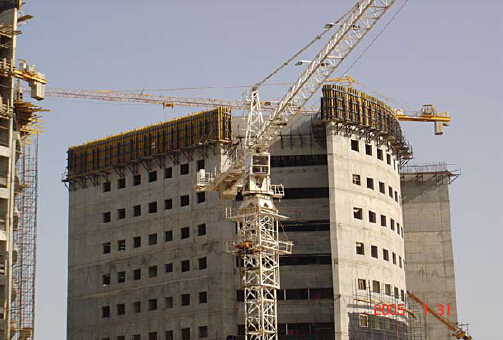
- Q: Can steel formwork be used for underground parking structures?
- Yes, steel formwork can be used for underground parking structures. Steel formwork provides a strong and durable solution for constructing the walls, columns, and slabs of underground parking structures. It offers several advantages such as high strength, flexibility, and the ability to withstand the pressure exerted by the soil and water in underground conditions. Steel formwork also allows for faster construction compared to traditional formwork systems, as it can be easily assembled and disassembled, and it requires minimal maintenance. Additionally, steel formwork is reusable, making it a cost-effective choice for underground parking structures. Overall, steel formwork is a suitable and efficient option for constructing underground parking structures.
- Q: Can steel formwork be used for architectural concrete slabs with embedded elements?
- Certainly, architectural concrete slabs with embedded elements can indeed make use of steel formwork. The utilization of steel formwork facilitates the pouring and shaping of concrete, as it furnishes a robust and long-lasting framework. This framework enables the precise and accurate positioning of embedded components, encompassing pipes, electrical conduits, and reinforcement bars. Additionally, steel formwork boasts the benefit of being reusable, rendering it an economically viable option for construction ventures. Furthermore, thanks to the sleek surface offered by steel formwork, the end result is a superbly refined finish for architectural concrete slabs.
- Q: What type of concrete finishes can be achieved with steel formwork?
- Steel formwork allows for a wide range of concrete finishes to be achieved. One of the most common finishes is a smooth and flat surface, which is achieved by using steel formwork that has a smooth texture. This finish is ideal for areas that require a level and even surface, such as floors and walls. Another type of finish that can be achieved with steel formwork is a textured or patterned surface. This can be achieved by using steel formwork that has a textured or patterned surface itself, or by using additional materials such as rubber or plastic liners that create the desired texture or pattern. This finish is often used for decorative purposes, such as in architectural concrete elements or for exposed aggregate finishes. In addition to the above, steel formwork can also be used to create curved or shaped concrete surfaces. This is achieved by bending or shaping the steel formwork to the desired shape before pouring the concrete. This type of finish is commonly used in architectural or artistic applications, where unique and aesthetically pleasing shapes are desired. Overall, steel formwork provides a versatile option for achieving a wide range of concrete finishes, including smooth, textured, patterned, and curved surfaces. The choice of finish depends on the specific requirements and desired aesthetics of the project.
- Q: What are the considerations when designing steel formwork for architectural features?
- When designing steel formwork for architectural features, there are several considerations that need to be taken into account. Firstly, the formwork design should align with the desired aesthetic of the architectural feature, ensuring that it complements the overall design intent. Additionally, the formwork needs to be structurally sound and capable of supporting the weight and forces exerted by the concrete during pouring and curing. It is important to consider the ease of assembly and disassembly of the formwork to ensure efficiency in construction. Furthermore, the formwork design should allow for proper placement of reinforcement and any necessary inserts or embedded items. Finally, considerations such as cost, durability, and maintenance should also be factored in to ensure the longevity and functionality of the steel formwork.
- Q: Are there any special considerations when using steel formwork in cold weather conditions?
- Yes, there are several special considerations when using steel formwork in cold weather conditions. Firstly, steel can become brittle at low temperatures, so it is important to ensure that the formwork is adequately heated to prevent cracking or structural failures. Additionally, cold temperatures can affect the curing process of concrete, so it is necessary to use temperature-controlled curing techniques and ensure proper insulation of the formwork. Lastly, freezing temperatures can cause ice to form on the formwork, which may affect the quality of the finished concrete. Therefore, it is crucial to regularly inspect and remove any ice buildup to maintain the integrity of the steel formwork.
- Q: What are the different types of lifting systems used with steel formwork?
- There are several types of lifting systems used with steel formwork, including manual lifting, crane lifting, hydraulic lifting, and mechanical lifting. Each system has its own advantages and is chosen based on the specific requirements of the construction project.
- Q: How does steel formwork handle different concrete finishing techniques?
- Steel formwork is very versatile and can handle various concrete finishing techniques with ease. Its sturdy and rigid structure allows for smooth and precise concrete finishes, regardless of the technique used. Steel formwork ensures that the concrete is held securely in place during the pouring and setting process, allowing for intricate detailing and precise shaping. Whether it's a smooth finish, textured patterns, or decorative imprints, steel formwork provides the necessary support and stability to achieve the desired concrete finishing technique effectively.
- Q: Can steel formwork be used for both residential and industrial construction projects?
- Yes, steel formwork can be used for both residential and industrial construction projects. Steel formwork is highly versatile and can withstand heavy loads, making it suitable for various construction applications. Its durability and strength make it ideal for use in both residential and industrial settings.
- Q: What is the 86 series steel formwork
- As with reinforced protection, it is easy to provide adequate protection for quick and easy closing, including the use of wood or plastic, steel wire tied steel or directly fixed to the soffit or face material.In the construction industry is widely used, it is difficult to see the wooden template
- Q: I would like to ask you 60 models of building steel formwork, steel mold fixed method and fixed plate type fixed hole number
- Wood formwork is now commonly used in some special shaped concrete members, because it is easier to cut, production.
Send your message to us
Single-Side Climbing Bracket for formwork and scaffolding system
- Loading Port:
- Tianjin
- Payment Terms:
- TT OR LC
- Min Order Qty:
- 50 m²
- Supply Capability:
- 1000 m²/month
OKorder Service Pledge
OKorder Financial Service
Similar products
Hot products
Hot Searches
